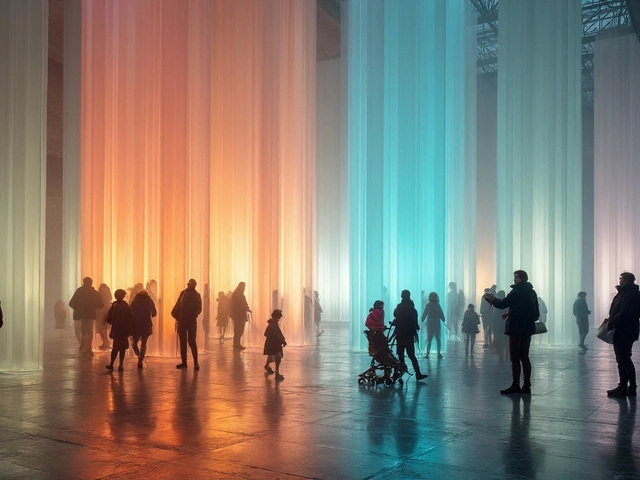The Birth of Suprematism: Breaking the Chains of Artistic Convention
Canvassing back to the early 20th century when all forms of art remained lodged in the vestiges of popular trends and styles like Impressionism, Neo-Impressionism, and Expressionism, a new art movement emerged that defied the realms of traditional artistic expression. Ladies and gentlemen, step aside to welcome Suprematism - pronounced as a revolutionary wave in the artistic world. This is not my usual geek-out moment over the latest tech gadget or drone. No, today I'm giddy over an art movement! Who would have thought that your tech-savvy, gadget-loving Sebastian could harbor an affection for something so analogue?
Suprematism, coined by its founder, Kazimir Malevich, was a movement that dared to reduce everything to pure geometric forms and fundamental colours. It rejected the representation of the world as it appears visually, instead prioritising the 'supremacy of pure feeling or perception' in the creative process. Much like when I display utter fascination upon getting hold of the latest piece of technology, Suprematism exhibited a similar passion for the possibility of the 'new'.
This dramatic shift towards abstraction was viewed as an escape from the constraints of the existing artistic norms. As an average New Zealander, essentially stuck in the peaceful isolation of the Pacific, it makes me wonder how the chaos of World War I might have sparked such a radical way of thinking at that time. Perhaps we need a kind of war against our own cultural lethargy to provoke such a revolution here in Auckland, albeit a peaceful one, thank the Kiwi Gods!
The Revolutionary Impact of Suprematism on Visual Art
Suprematism left an indelible mark on the world of visual art. This revolutionary movement has success in freeing artistic expression from the shackles of traditional representation. Even the rugby-obsessed horde in my local pub could probably endeavour to comprehend a Suprematist painting with a guiding nudge. On a side note, how gratifying it is when a seemingly unknowing audience grasps abstract art!
An understanding of the Suprematist revolution is somewhat akin to comprehending that moment when our treasured All Blacks stole the Rugby Union World Cup right under the noses of our rivals. It was a rebellion against the classicism of conventional forms of play, teasing out the pure aesthetic emotion from within art. Suprematism has opened up chances for more aesthetical and emotional interpretation as opposed to the mechanical reproduction of realism.
Feeding into an artistic world that was screaming for something different from the cyclical reproduction of visual reality, Suprematism offered unparalleled freedom for artists to represent their intangible thoughts and emotions. It's like when you ditch your everyday, routine-driven life for an adrenaline-filled, seat-of-your-pants adventure with only your intuition as a guide. The same exhilaration can be found in this dramatic shift in the artistic landscape.
The Hallmark of Suprematism: Geometric Forms and Fundamental Colours
Imagine the world as a child would, with simple basic shapes and colours – circles, squares, rectangles, painted in bright primaries. It's like the simple joy of eating my mother's homemade shepherd's pie on a drizzly winter day in Auckland. The mere thought of experiencing those delights, unspoiled by the superficiality or complexity of the adult world, brings a profound sense of earthly pleasure.
In the same vein, Suprematism radiates that sense of unsophisticated joy through its distinct adherence to basic geometric forms and primary colours. It's a recognition of the essential, the raw, the uncluttered. It's as though the world's pressing 'control, alt, delete' on all the aesthetically ornate and culturally loaded art, enabling an artistic reboot with Suprematism.
But let's not be beguiled into thinking that this renders Suprematism simplistic or easy to comprehend. On the contrary, these minimalist artworks often present the biggest challenges for interpretation, prompting us to delve deep into our subconscious, just as I often find myself giggling like a child at the perplexity of connect-the-dot puzzles.
Suprematism's Legacy: Influencing Modern and Contemporary Art
The influence of Suprematism has been widely spread, infiltrating various phases of modern and contemporary art. For me, it's like watching components of my favourite childhood Lego set crop up in the current high-tech versions. It brings a sense of nostalgia while at the same time providing a thrill of the 'new'.
From architecture and graphic design to fashion and film, evidence of Suprematism's minimalist aesthetic can be seen. The raw purity and the 'less is more' ethos of the movement echo in the designs of modern maestros like Zaha Hadid and the late Steve Jobs. Think of the sleek, simplistic designs Apple is renowned for, a prime example of Suprematist influence.
Quite frankly, I find myself gazing at Hadid's and Job's minimalist designs, feeling that same sense of awe that I suspect that first audience felt when they encountered a Malevich masterpiece. And I would be enormously proud if any of my Aucklandian mates could appreciate this same connection between creative epochs, bridged by the essence of Suprematism.
Reviving Suprematism: Echoing in the Halls of Contemporary Culture
Inevitably, culture evolves, yet the echoes of revolutionary movements like Suprematism remain, rippling in the undercurrent of our present-day entertainment industry. As an enthusiastic instrumentalist, my admiration goes out to the music video creators who have rekindled this once radical art movement.
Take the contemporary music scene, for instance. I find traces of Suprematism in the abstract backdrops and stage designs, emphasizing geometric forms, primary colors and spatial interaction, much like a Malevich painting come to life. I once danced in a club in Auckland, swirling around amidst flashing, geometric visuals, only to realize a moment later - I was in the middle of a Suprematist reverie!
So, there you have it! Suprematism, once a pioneering manoeuvre in the visual arts, continues to impact our contemporary culture. From abstract stage design to minimalist apps, and even to game strategy - anyone up for a round of Tetris, perhaps?
Whether you're an artist, a developer, or, like me, simply a keen observer, recognising and appreciating the Suprematist legacy enforces one’s understanding of the evolution of creative expression. This radical break from the past continues to reverberate in our modern world. Next time you catch a visually appealing geometric pattern or a stunningly simple design, give a tip of your hat to Suprematism, the movement that dared to redefine artistic expression.




